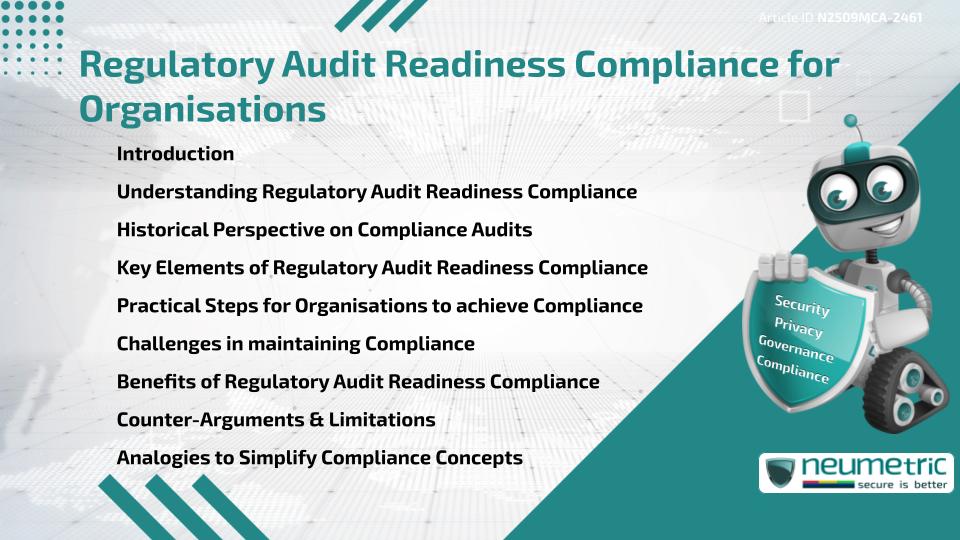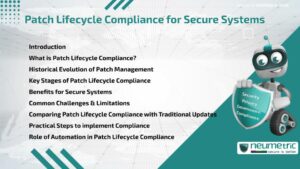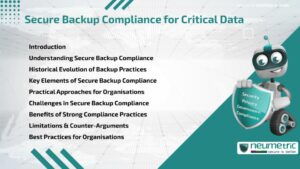Table of Contents
ToggleIntroduction
Regulatory Audit readiness compliance is the structured process by which organisations prepare for external audits conducted by regulators, industry bodies or Certification authorities. It ensures that Policies, procedures & practices align with applicable laws, standards & frameworks. For organisations, being Audit-ready minimizes Risks of penalties, strengthens Governance & demonstrates a commitment to accountability. This article explores the history, key elements, challenges, benefits & practical steps involved in regulatory Audit readiness compliance, along with balanced viewpoints & easy-to-grasp comparisons.
Understanding Regulatory Audit Readiness Compliance
At its core, regulatory Audit readiness compliance means building a state of continuous preparedness. It requires not only meeting compliance standards but also maintaining documentation, Evidence & processes that can withstand regulatory scrutiny. For instance, Financial institutions must align with reporting standards, Healthcare providers must meet Patient Data regulations & manufacturers must follow product safety guidelines.
By focusing on readiness rather than last-minute preparation, organisations create a culture where compliance becomes second nature rather than a stressful exercise.
Historical Perspective on Compliance Audits
The concept of audits can be traced back to ancient civilizations, where rulers inspected Financial records to ensure fairness in tax collection. In the modern era, compliance audits gained momentum during the industrial revolution, as governments introduced labor & safety laws. By the twentieth century, specific frameworks like occupational safety standards, Financial reporting rules & Data Protection laws became common.
Today, regulatory Audit readiness compliance reflects this evolution, requiring organisations to embed compliance as a continuous discipline rather than an occasional activity.
Key Elements of Regulatory Audit Readiness Compliance
Several components make up effective Audit readiness:
- Policies & Procedures: Clear documentation that reflects regulations & internal practices.
- Training & Awareness: Staff must understand compliance responsibilities.
- Monitoring & Internal Audits: Regular checks identify gaps before external audits.
- Documentation & Evidence: Proof of compliance such as logs, reports & approvals.
- Leadership Oversight: Executives must champion compliance as a business priority.
Without these elements, regulatory Audit readiness compliance becomes inconsistent & vulnerable to errors.
Practical Steps for Organisations to achieve Compliance
Organisations can achieve compliance by following practical steps:
- Assess Regulations: Identify all relevant laws & frameworks.
- Gap Analysis: Compare current practices against requirements.
- Remediation: Address identified weaknesses with corrective measures.
- Automation Tools: Use technology to monitor compliance continuously.
- Regular Reviews: Conduct internal audits at defined intervals.
These steps create a cycle of preparedness that avoids surprises during external inspections.
Challenges in maintaining Compliance
Despite best efforts, organisations face hurdles in maintaining regulatory Audit readiness compliance. Regulations often change rapidly, making it difficult to stay updated. Resource constraints also limit the ability of smaller organisations to invest in compliance tools or staff. Moreover, balancing compliance with day-to-day business priorities can be challenging.
Benefits of Regulatory Audit Readiness Compliance
Being Audit-ready offers significant benefits:
- Reduced Risk: Minimises chances of fines, sanctions or reputational damage.
- Operational Efficiency: Streamlined processes improve productivity.
- Stakeholder Trust: Clients, partners & regulators gain confidence in the organisation.
- Resilience: Audit readiness helps organisations adapt to regulatory changes smoothly.
Counter-Arguments & Limitations
Some critics argue that regulatory Audit readiness compliance creates unnecessary administrative burden. Others claim that too much focus on audits may shift attention away from innovation & business growth. While these concerns are valid, ignoring compliance altogether exposes organisations to severe legal & Financial Risks. A balanced approach ensures that compliance supports business goals rather than obstructs them.
Analogies to Simplify Compliance Concepts
Think of regulatory Audit readiness compliance like maintaining a car. Regular servicing, timely oil changes & safety checks ensure the car runs smoothly. Waiting until the day of a long road trip to fix problems is risky & costly. Similarly, organisations that embed compliance into routine operations are better prepared when regulators arrive.
Takeaways
Regulatory Audit readiness compliance is not a one-time project but a continuous commitment. By embedding compliance into Policies, training, monitoring & leadership oversight, organisations can reduce Risks, build trust & improve efficiency. While challenges exist, the long-term benefits of readiness outweigh the short-term burdens.
FAQ
What is regulatory Audit readiness compliance?
It is the ongoing process of preparing an organisation to meet external regulatory Audit requirements by maintaining compliance at all times.
Why is regulatory Audit readiness compliance important for organisations?
It helps reduce penalties, increases Stakeholder trust, improves efficiency & strengthens Governance.
What are common challenges in achieving compliance?
Frequent regulatory changes, resource limitations & balancing compliance with Business Operations are the most common challenges.
How often should internal audits be conducted for compliance readiness?
Organisations should conduct internal audits regularly, ideally at least once every year, with more frequent reviews for high-Risk areas.
Can small organisations achieve regulatory Audit readiness compliance?
Yes, smaller organisations can achieve compliance by prioritising key regulations, using affordable tools & focusing on staff awareness.
Does compliance readiness require technology?
While not mandatory, technology simplifies monitoring, Evidence collection & reporting, making readiness more effective.
How does compliance readiness affect business reputation?
Being Audit-ready shows commitment to Transparency & Accountability, which strengthens Customer & partner confidence.
Need help for Security, Privacy, Governance & VAPT?
Neumetric provides organisations the necessary help to achieve their Cybersecurity, Compliance, Governance, Privacy, Certifications & Pentesting needs.
Organisations & Businesses, specifically those which provide SaaS & AI Solutions in the Fintech, BFSI & other regulated sectors, usually need a Cybersecurity Partner for meeting & maintaining the ongoing Security & Privacy needs & requirements of their Enterprise Clients & Privacy conscious Customers.
SOC 2, ISO 27001, ISO 42001, NIST, HIPAA, HECVAT, EU GDPR are some of the Frameworks that are served by Fusion – a SaaS, multimodular, multitenant, centralised, automated, Cybersecurity & Compliance Management system.
Neumetric also provides Expert Services for technical security which covers VAPT for Web Applications, APIs, iOS & Android Mobile Apps, Security Testing for AWS & other Cloud Environments & Cloud Infrastructure & other similar scopes.
Reach out to us by Email or filling out the Contact Form…





